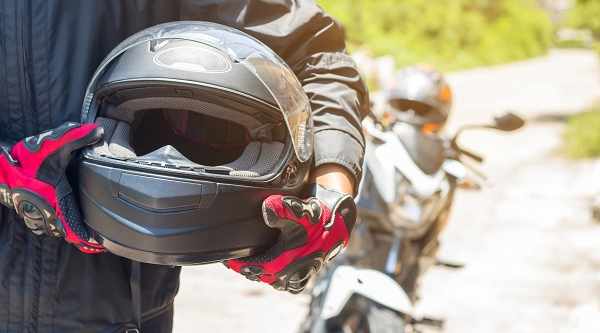Motorcycles are inherently dangerous given the unprotected nature of the vehicle while traveling at high speeds, which is why protective motorcycle safety gear is extremely important. As a new motorcycle rider, it is important to understand and familiarize yourself with the basic safety gear necessary while riding.

Types of Motorcycle Helmets
There are several different types of motorcycle helmets available which vary in shape, color, design features, and level of protection. Some of the most common types of motorcycle helmets include:
- Full-face helmet: This type of helmet covers the entire head, including the chin and face. It provides the most protection and prevention from head trauma and is commonly used for sport riding and racing.
- Open-face helmet: Also known as a 3/4 helmet, this type of helmet covers the top and sides of the head but leaves the face and chin exposed. It provides less protection than a full-face helmet but is popular among cruisers and vintage bike riders.
- Modular helmet: A modular helmet combines the features of a full-face and open-face helmet. It has a chin bar that can be flipped up, allowing the rider to talk or eat without removing the entire helmet.
- Half helmet: Also known as a beanie helmet, this type of helmet covers only the top of the head and provides the least amount of protection. It is typically used for short rides or by riders who prioritize style over safety.
- Dual-sport helmet: This type of helmet is designed for both on-road and off-road riding. It features a large visor and a chin bar that can be removed for street riding.
When choosing a motorcycle helmet, it’s important to purchase one that fits properly and has been certified by a recognized safety organization, such as the Department of Transportation (DOT). Motorcycle helmets are the most important piece of safety gear and are legally required in almost all states given the high risk of catastrophic injury when riding without a helmet.
Purpose of a Motorcycle Jacket
The purpose of a motorcycle jacket is to provide protection for a motorcycle rider’s upper body in the event of an accident or crash. A motorcycle jacket is typically made of abrasion-resistant materials, such as leather or textile, and is designed to withstand the forces that a rider may experience during a crash. A motorcycle jacket can also provide impact protection through the use of armor inserts in key areas such as the elbows, shoulders, and back. These inserts are typically made of materials such as foam, plastic, or carbon fiber and are designed to absorb shock and distribute impact forces.
Depending on the type and style of motorcycle jacket, some can also provide additional safety features such as high-visibility colors or reflective materials to increase visibility to other drivers on the road, particularly in low-light conditions. Wearing a motorcycle jacket while riding is an important safety measure to not only protect against road rash and impact forces in the event of a collision, but also increase visibility on the road.
Protective Motorcycle Pants
Motorcycle pants provide protection and safety for motorcyclists in several ways. Pants designed for motorcycle riding are typically made from materials such as leather, Kevlar, or textile that are able to withstand abrasions from sliding on concrete or pavement in the event of a crash. These materials are durable and can help prevent road rash and other injuries.
Many motorcycle pants come with armor inserts in areas such as the elbows, knees, and hips to protect against impacts during a crash. These inserts are typically made from materials such as foam, plastic, or carbon fiber and can help distribute the impact force from a fall off a motorcycle. Similar to a motorcycle jacket, motorcycle pants can provide increased visibility for other drivers on the road, while also providing weather protection.
Durable and Supportive Motorcycle Riding Boots
Motorcycle riding boots are an essential piece of safety gear for riders. Wearing durable and supportive motorcycle riding boots contribute to safe riding by providing protection for the rider`s feet and ankles. Most motorcycle boots are made of high quality and protective materials such as leather or synthetic textiles and are often designed with reinforced toe caps, ankle protectors, and other safety features to prevent injuries from impacts in the event of a crash.
Motorcycle boots provide functional support for riders and often have specialized soles that help with better grip and control on the foot pegs, as well as the pavement when stopped. This can help prevent slips or falls, which can be dangerous in traffic or at high speeds. Wearing motorcycle boots while riding also provides protection during harsh weather conditions such as rain, wind, and cold temperatures.
Gloves For Hand Protection
Gloves are an important piece of safety gear for motorcycle riders and provide protection from abrasions, cuts, and road rash on the rider`s hands which are common injuries in motorcycle accidents. Motorcycle gloves are designed to provide better grip on the handlebars, which is essential for maintaining control of the bike. This can be especially important in wet or slippery conditions. Wearing protective motorcycle riding gloves can also help prevent blisters and calluses that may form over time as a result of prolonged gripping of the handlebars.
Gloves are important to provide protection from harsh weather conditions, such as cold temperatures, wind, and rain. These conditions not only cause discomfort, but can also affect a rider’s ability to control the motorcycle. Many gloves are designed to be windproof, waterproof, or insulated to provide protection in a variety of weather conditions.

